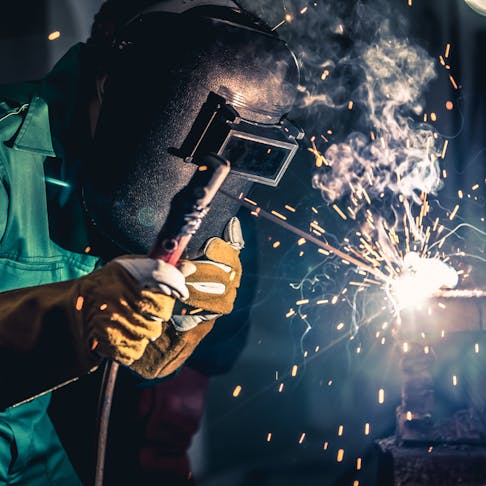SMAW (Shielded Metal Arc Welding) and GMAW (Gas Metal Arc Welding), commonly referred to as MIG (Metal Inert Gas) welding, are two widely used welding processes with distinct characteristics, techniques, and applications. SMAW is a manual process that uses a flux-coated electrode, while GMAW relies on a continuously fed wire and an external shielding gas.
Each method has advantages depending on the materials involved, the required weld quality, and the working environment. This article compares SMAW vs. GMAW in terms of process, equipment, use cases, benefits, and limitations to help identify the right approach for specific welding needs.
What Is Shielded Metal Arc Welding (SMAW)?
Shielded Metal Arc Welding (SMAW), also known as "stick welding," is a widely used manual welding process. It uses a flux-coated electrode and is valued for its portability and minimal equipment requirements. SMAW is popular in construction, pipeline welding, maintenance, and field repair work.
How Does Shielded Metal Arc Welding (SMAW) Work?
SMAW is a manual welding process. It involves creating an electric arc between a coated electrode (stick) and the part. The heat generated melts both the electrode and the base material, forming a weld pool. The flux coating decomposes to release shielding gases and create a slag that protects the molten weld from atmospheric contamination. As the weld cools, it solidifies and joins the workpieces together.
What Is the Main Use of Shielded Metal Arc Welding (SMAW)?
SMAW is primarily used for repair welding and field fabrication, particularly in environments where portability and minimal equipment are essential. It is versatile and applicable in all welding positions on ferrous metals, including steel and iron. SMAW's flexibility makes it suitable for a wide range of welding applications across various industries.
What Are the Advantages of Shielded Metal Arc Welding (SMAW)?
Advantages of SMAW include:
- It can be used on various ferrous metals.
- Requires minimal equipment, making it suitable for remote locations.
- It can be used in all welding positions.
- Lower initial equipment and setup costs compared to processes like tungsten inert gas (TIG) welding, though consumable and post-processing needs may vary depending on the application.
What Are the Disadvantages of Shielded Metal Arc Welding (SMAW)?
Disadvantages of SMAW include:
- Slag inclusions can occur if not properly cleaned between passes, potentially compromising weld quality and requiring additional post-processing.
- This welding process is intermittent since the electrode must be replaced periodically.
- Produces significant heat, smoke, and spatter, requiring appropriate personal protective equipment (PPE), ventilation, and adherence to safety protocols.
What Is Gas Metal Arc Welding (GMAW)?
Gas metal arc welding (GMAW) is a semi-automated process that uses a continuous wire electrode and shielding gas. It is widely used in industries such as automotive, aerospace, and manufacturing for welding steel, aluminum, and other metals. GMAW is favored for its speed, efficiency, and clean welds. Figure 1 below is an example of gas metal arc welding:

How Does Gas Metal Arc Welding (GMAW) Work?
GMAW works by creating an electric arc between the part and a continuous wire electrode. The electrode, which is fed through a welding gun, melts and combines with the workpiece to form a weld. A shielding gas, such as argon or a mixture of argon and carbon dioxide, is used to protect the weld zone from atmospheric contamination. The shielding gas also helps stabilize the arc and control the welding process.
What Is the Main Use of Gas Metal Arc Welding (GMAW)?
GMAW is widely used in semi-automated or automated industrial welding applications. While it is versatile and suitable for many metals, including steel, aluminum, and stainless steel, it is not commonly used for all commercially available metals, especially those requiring special shielding gases or filler materials. Its ability to deliver high-speed, consistent welds makes it ideal for light to medium gauge metals, rather than deep groove welding of thick castings.
What Are the Advantages of Gas Metal Arc Welding (GMAW)?
Advantages of GMAW include:
- It offers faster welding speeds than other processes.
- Can weld a wide range of metals, including steel, aluminum, and stainless steel.
- Provides excellent weld appearance and soundness.
- Minimal slag and spatter formation.
- Well-suited for semi-automated or fully automated welding systems.
What Are the Disadvantages of Gas Metal Arc Welding (GMAW)?
Disadvantages of GMAW include:
- Limited portability compared to Shielded Metal Arc Welding (SMAW).
- Sensitivity to drafts or outdoor conditions that can disrupt the shielding gas.
- Requires specialized equipment, including a welding power source and shielding gas supply.
- The absence of a slag system in GMAW can make out-of-position welds more challenging, especially in vertical or overhead positions where molten metal control is more difficult.
How Does SMAW Differ from GMAW?
SMAW and GMAW differ primarily in their equipment setup, welding technique, and use cases. SMAW, or stick welding, is a manual process using a flux-coated electrode that generates its own shielding gas and slag. GMAW uses a continuous wire electrode and external shielding gas delivered through a welding gun. While SMAW is valued for its portability and simplicity, GMAW is known for higher welding speeds, cleaner welds, and compatibility with automation. Each method has advantages depending on the application, environment, and material type.
How Do SMAW and GMAW Differ in the Types of Gas Used?
SMAW and GMAW differ in the types of gas used for shielding. SMAW does not use an external shielding gas. Instead, it utilizes a flux-coated electrode that decomposes to release shielding gases (primarily carbon dioxide and water vapor) and forms a slag. This combination creates a shielded environment around the weld area, safeguarding it against contamination and maintaining the weld's integrity. In contrast, GMAW relies on an external shielding gas, such as argon or a mixture of argon and carbon dioxide, for weld protection.
Why Is SMAW the Most Widely Used Welding Process?
SMAW (Shielded Metal Arc Welding) is one of the most widely used welding processes due to its simplicity and self-contained nature. It does not require a separate shielding gas cylinder, making it highly convenient for on-site welding. Additionally, SMAW offers cost-effective solutions and is well-suited for field repairs and construction.
Is SMAW Stronger Than GMAW?
No, SMAW is not inherently stronger than GMAW. The strength of a weld depends on various factors such as welding technique, filler material, and base metal. Both SMAW and GMAW can produce high-strength welds when performed correctly and with appropriate materials.
Is GMAW the Same as MIG Welding?
Yes, MIG welding is a common term used to describe GMAW. Technically, MIG refers to a subtype of GMAW that uses inert shielding gases like argon. However, in modern usage, "MIG welding" and "GMAW" are often used interchangeably, especially when referring to welding with solid wire and shielding gas.
How Do GMAW and SMAW Differ in Material to Weld?
GMAW is compatible with a broader range of materials than SMAW. GMAW can effectively weld steel, stainless steel, aluminum, and non-ferrous metals, making it ideal for industries that require versatility. SMAW is primarily suited for ferrous metals such as carbon steel, iron, and cast iron. While SMAW can handle rough or dirty surfaces better, GMAW offers more refined results on clean, uniform materials. The material type, thickness, and required weld quality should guide the choice between the two methods.
Does GMAW Equipment Cost More Than SMAW Equipment?
Yes, GMAW equipment generally costs more than SMAW equipment. GMAW requires a welding power source, wire feeder, welding gun, and an external shielding gas supply, which can contribute to higher initial costs. SMAW, being a more straightforward process, has simpler equipment requirements. It only requires a power source, electrode holder, ground clamp, and SMAW electrodes. This results in lower overall equipment costs. GMAW equipment tends to cost more than SMAW equipment due to the inclusion of additional components such as a shielding gas cylinder and welding gun.
How Do SMAW and GMAW Differ in the Process?
The key difference between SMAW and GMAW lies in how the arc is generated and maintained during welding. In SMAW, the operator manually feeds a stick electrode into the arc zone, with the flux coating producing the shielding gases and slag as it burns. The electrode must be frequently replaced, making the process more hands-on. GMAW, on the other hand, feeds a continuous wire electrode automatically through a gun, along with a steady flow of shielding gas like argon or CO₂. This allows for longer, uninterrupted welds and more consistent control over arc and deposition rate.
Is SMAW Easier To Use Than GMAW?
No, SMAW is not generally considered simpler to use than GMAW. Due to challenges such as slag removal, arc length control, and manual electrode handling, SMAW typically requires more operator skill and technique. In contrast, GMAW offers more automation and control, making it easier to operate and learn.
Summary
This article presented SMAW and GMAW, explained each of them, and discussed their key differences. To learn more about both welding processes, contact a Xometry representative.
Xometry provides a wide range of manufacturing capabilities, including sheet cutting and other value-added services for all of your prototyping and production needs. Visit our website to learn more or to request a free, no-obligation quote.
Disclaimer
The content appearing on this webpage is for informational purposes only. Xometry makes no representation or warranty of any kind, be it expressed or implied, as to the accuracy, completeness, or validity of the information. Any performance parameters, geometric tolerances, specific design features, quality and types of materials, or processes should not be inferred to represent what will be delivered by third-party suppliers or manufacturers through Xometry’s network. Buyers seeking quotes for parts are responsible for defining the specific requirements for those parts. Please refer to our terms and conditions for more information.


